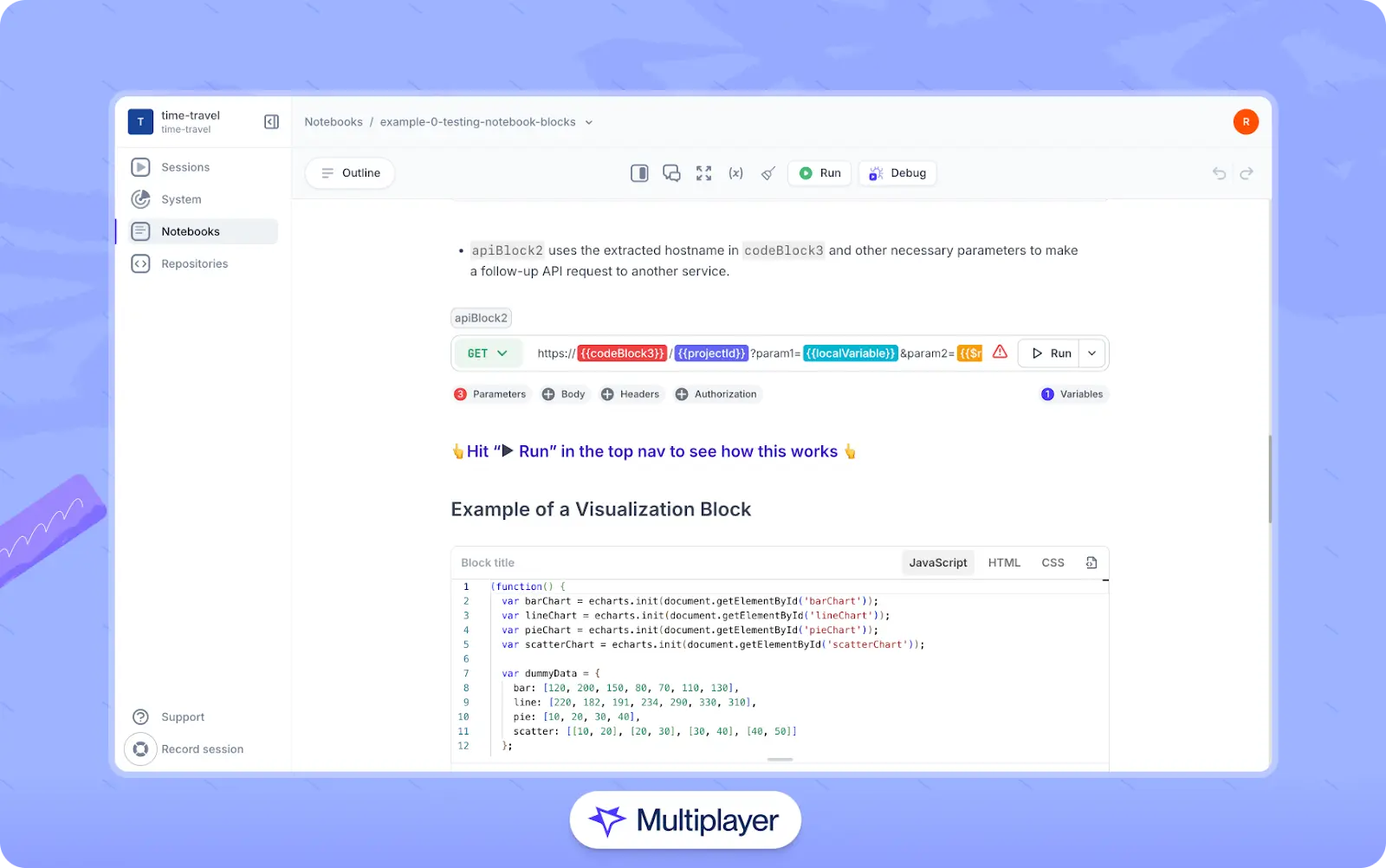Guide
Bug Tracking System: The Must-Have Features
Table of Contents
The term "bug" refers to any software behavior that deviates from what is expected. Bugs can arise from broken code, gaps in documentation, or misunderstood requirements.
While it is not reasonable to expect a system to be entirely devoid of issues, it is possible to aim to create systems that are as reliable and bug-free as possible. Incorporating a strong bug-tracking workflow into your development process is an important step in this process because it allows your teams to organize, prioritize, and resolve issues more efficiently. A strong bug-tracking workflow provides better visibility of the bugs in the system, helps catch regressions, and aids in faster issue resolution.
This article explores different bug-tracking workflows that teams can integrate into their development cycles. We discuss the key benefits of such workflows and whether using a single dedicated tool to triage bugs or employing multiple tools makes more sense.
Summary of key bug tracking system concepts
| Concept | Description |
|---|---|
| What is a bug tracking system? | A bug tracking system is a structured workflow that uses various tools to document, prioritize, and resolve software issues efficiently. |
| Components of a bug tracking system | A bug tracking system should support issue logging and classification, allow team members to create detailed documentation, integrate with external tools, and provide reporting and analytics features. |
| Selecting the proper tooling | Selecting the right bug tracking tools depends on product complexity, team size and collaboration needs, and system requirements. |
| Implementing an effective bug tracking system | An effective bug tracking system relies on clear reporting, defined workflows, debugging tools, regular triaging, and continuous improvement based on past releases and incidents. |
What is a bug tracking system?
A bug tracking system is a developmental workflow that leverages different tools to document, track, and help resolve issues. Depending on your organization's needs and resources, you can either use a single tool to organize bugs or multiple tools to make the process more efficient. The main goal of a bug tracking system is to alert the team about issues and provide insights to make them easier to reproduce and fix.
Life cycle of a bug
Before discussing bug tracking systems in depth, it is helpful to outline the typical journey a bug takes from discovery to closure:
- Identification and Reporting: When a tester, developer, or user encounters unexpected behavior in the system, the issue is logged in a bug tracking tool like Jira or GitHub Issues. This report should provide all the information relevant to reproducing and resolving the bug. In a traditional workflow, this would include steps to reproduce, actual result, expected result, screenshots, videos, logs, test environment, etc. However, this can be simplified by capturing full-stack session recordings, which we discuss later in this article.
- Triage: Team members—often QA leads, project managers, or product owners—review the bug report to determine its severity, priority, and validity. They decide whether to resolve the bug within the current sprint or put it in a backlog for future resolution. At this stage, a valid bug is marked as "New" or "Open" depending on the team's tools and workflow.
- Assignment: A developer is assigned a ticket to investigate and resolve the bug within a sprint.
- Debugging and resolution: The developer investigates the issue using the details provided in the bug report, attempting to reproduce the problem, analyze its root cause, and work toward a resolution. In some cases, the fix may require changes at the code level; in others, it may involve clarifying or updating missing requirements in the documentation. If the developer cannot reproduce the issue, it might get closed or returned for clarification.
- Code review and testing: The fix undergoes peer review to ensure code quality and consistency. Once merged, it's deployed to a staging/QA environment, where testers validate against the original steps.
- Retesting: Testers confirm that the specific issue no longer occurs.
- Regression testing: Automated and/or manual tests run to ensure that the fix hasn't introduced new problems. This usually happens as part of the CI pipeline and again in staging.
- Closure: If the fix is successfully verified, the bug is marked as Closed. If the issue persists, it may be reopened and sent back for further investigation and resolution.
Understanding this life cycle provides context for why certain fields exist in issue trackers, why workflows enforce specific states, and how developers, testers, and product owners collaborate.
The importance of a bug tracking system
A bug tracking system adds structure and transparency to defect management systems. Rather than bugs living in spreadsheets, Slack threads, or someone's memory, all information is centralized in one place and accessible to the whole team. That centralization matters because it makes triage easier, ensures that the most critical issues are prioritized, and keeps sprint planning grounded in reality.
Good tracking tools also keep conversations tied to the bug itself. Comments, updates, and links to fixes live in the report, so you don't waste time chasing context across emails or chat logs. Over time, the system becomes more of a knowledge base than a queue of tickets. Teams can spot recurring issues, see which areas of the codebase are fragile, and put measures in place to prevent the same class of bug from resurfacing.
In short, bug tracking tools help close bugs faster and help teams ship more reliable software by making an issue's lifecycle visible, traceable, and collaborative.
Full-stack session recording
Learn moreComponents of a bug tracking system
The key to an effective bug tracking system is finding one or more tools that streamline issue management and resolution rather than adding unnecessary complexity. In this section, we look at some of the features you'll need.
Issue tracking and management
Your system should include a user-friendly interface that's straightforward enough for team members to quickly log and categorize issues without friction while capturing all the necessary details. Priority settings must be clear and consistent so everyone understands what requires immediate attention and what can wait for the next sprint.
The system should also provide a centralized view where you can see the status of all issues, track who is responsible for what, and monitor progress from discovery to resolution.
Attachments and documentation
A bug tracking system should allow team members to attach screenshots, logs, videos, or other relevant files to each bug report. This provides full context and makes it much easier for developers to understand the issue without needing extra information.
While this can be done with screenshots or copied log snippets, modern tools can ease the bug documentation and resolution processes considerably. For example, Multiplayer's full-stack session recordings allow developers to capture end-to-end recordings of an issue that include frontend screens, backend traces/metrics/logs, and full request/response payloads. These recordings can also be used to automatically generate notebooks with runnable test scripts, written documentation, and executable code and API blocks.

Multiplayer notebooks
Searching, filtering, and customizable workflows
A good bug tracking tool should make finding and managing issues easy, even when hundreds or thousands of them exist. Advanced search and filters—such as by status, priority, or assignee—allow teams to quickly locate specific bugs or groups of bugs, saving time and reducing confusion.
Interact with full-stack session recordings to appreciate how they can help with debugging
EXPLORE THE SANDBOX(NO FORMS)
The tool should also support different stages of a ticket (such as "to-do," "in progress," and "done") and allow the team to customize labels to match its workflow. This helps everyone see exactly where each bug stands in the process, track progress more efficiently, and adjust the workflow to fit how the team works best.
Integration capabilities
An ideal bug tracking tool should easily integrate with your team's existing workflow. Integration with version control systems (like Git) allows bugs to be linked directly to specific commits, branches, or pull requests, making it easy to see which code changes introduced or fixed an issue. Some tools can even auto-close issues when the linked pull request is merged, reducing manual work and keeping the tracker up-to-date.
Additionally, API access and custom webhook integration let teams integrate the bug tracker with other platforms, such as sending a Slack notification when a bug report's status is updated. Integration with test management tools might benefit the QA and product teams. These tools store and organize test cases, test plans, and test runs, and, when connected with a bug tracker, provide a direct link between failed tests and reported bugs.
Reporting and analytics
Finally, a bug tracking system should provide reporting features that help teams understand their bug resolution patterns and overall quality trends. For example, seeing how long it usually takes to fix bugs (mean time to resolution) helps a team determine the right debugging process, while monitoring bug reopen rates can reveal whether issues are being addressed properly or tend to resurface. Evaluating how many bugs slip through to your users (escaped defect ratios) provides insights into how well the current testing process catches problems before they reach production. These metrics help teams decide where to invest their attention and resources.
Selecting the proper tooling
The right bug tracking system depends on the complexity of your product, how your team collaborates, and whether different stakeholders currently have enough context to resolve issues effectively. The goal is to provide developers with the information they need to fix problems quickly while making it easy for different team members to collaborate and stay informed.
One tool vs. multiple tools
An important decision to make is whether your organization requires multiple tools to track bugs. For smaller projects or applications with a stable feature set and user base, a single tool can be a simple and cost-effective initial solution. However, there are several reasons why larger organizations and more complex applications often require more than one tool in their bug tracking systems.
First, bug reports rarely come from one place. User reports may come through an application like Zendesk, while monitoring tools like Sentry could automatically collect crash or error reports. Consolidating these inputs requires tools that can centralize and correlate data from multiple channels.
Another reason is the involvement of cross-functional teams in the bug resolution process. Bug resolution often involves developers, QA, product managers, support, DevOps, and even UI/UX. Each team contributes different expertise, and no single tool usually covers all their needs.
Finally, legacy systems can also complicate matters. Bugs in these environments are notoriously tricky to reproduce because of outdated dependencies or complex, tightly coupled modules. In these environments, specialized tools that support dependency tracking, environment simulation, or containerization can make debugging more manageable.
One click. Full-stack visibility. All the data you need correlated in one session
RECORD A SESSION FOR FREEFactors to consider when selecting tools
Regardless of whether your team chooses one or multiple tools, there are several important factors to consider:
Integration with existing workflows
A bug tracking tool rarely exists in isolation. Consider how the tools you select integrate with your CI/CD pipeline, monitoring systems, and communication platforms. Strong integrations reduce the need for manual work, help prevent data silos, and help bugs move smoothly through the resolution process.
System requirements
Requirements include product-specific constraints–such as security or compliance concerns–deployment frequency, and user scale. If your system exists in a regulated environment, ensure your tools offer access controls and audit logging. Systems with frequent deployments or large user bases might need additional monitoring, debugging, and session recording tools beyond the basic bug tracking to provide the comprehensive visibility and detailed diagnostics necessary for maintaining system reliability and performance.
Capturing bug context
Bug reports must carry enough context to give different stakeholders the information they need. For developers, this often means access to logs, stack traces, or reproduction steps. For product and support teams, it's about understanding the exact user experience that led to the issue.
An effective way to address all of these needs is through the use of full-stack session recordings. Using a tool like Multiplayer, team members and users can capture front-end screens and user actions correlated with backend traces, metrics, logs, and full request/response content and headers. Recordings can be shared with all team members and serve as a complete bug report and a single source of truth.

Multiplayer's full-stack session recordings
Implementing an effective bug tracking system
Setting up an effective bug tracking system is not straightforward and involves trial and error. The best workflow for a team depends on the project's requirements and complexity. Some of the best practices for creating an effective bug tracking workflow include the following:
- Standardize bug reporting: Create a clear template for bug reports that includes sections like steps to reproduce, environment, expected behaviour, and other relevant data.
- Establish a straightforward bug lifecycle workflow: Define and document your bug statuses, such as To Do -> In progress -> In Review-> In Testing-> Done, so everyone knows how issues progress.
- Integrate debugging context directly into tickets: Encourage the use of tools that provide deep debugging context through full-stack session recordings. Attach recordings directly to bug tickets so developers don't waste time trying to reproduce issues.
- Prioritize and triage frequently: Create a routine to assess severity, assign ownership, and prioritize bug resolution so that bugs are solved promptly.
- Review and improve: Review the bug tracking system after major releases or incidents to identify missed bugs or ways to improve the workflow.
Stop coaxing your copilot. Feed it correlated session data that’s enriched and AI-ready.
START FOR FREELast thoughts
Bugs are inevitable in software development, but the right bug tracking system can bring structure, efficiency, and transparency to the resolution process. This article explored different bug-tracking workflows that teams can integrate into their development cycles. We discussed when using a single dedicated tool or multiple tools makes sense. Smaller teams with stable features and a low user base may find a single dedicated tool sufficient, while larger teams with complex systems and a large user base might need other tools besides the traditional bug tracking tool. We also explored how modern solutions like Multiplayer can enhance debugging and bug tracking in modern distributed systems.
Ultimately, an effective bug tracking system combines clear, standardized reporting, well-defined workflows, and advanced debugging tools to help teams identify, prioritize, and resolve issues efficiently. When you have a good bug tracking system in place, you start to see patterns that weren't obvious before. Maybe certain features consistently generate more issues, or bugs tend to cluster around a specific user workflow. The goal is to create a system that helps you catch issues early, fix them, and learn from them to prevent similar problems down the road.


